ossmaritime.como
With Dr. Reuben Goossens, PhD.
Maritime Historian, Author, Lecturer
Commenced in the Passenger Shipping &
Cruise Industry in 1960’s
The Dutch Ship ...
“De Zeven ProvinciŽn”
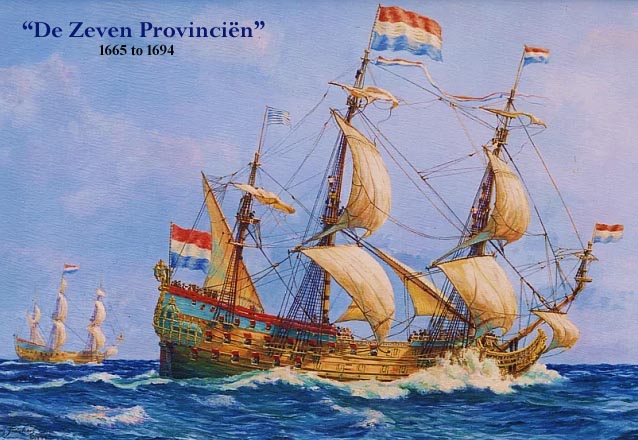
Provided by Dr.
Johannes Meijer.
Please Note: Most images on this page were kindly provided by “Thijs Meijer”,
unless noted otherwise - as we can see above!
Introduction:
I commenced writing
of this rather amazing ship back in early 2006, however due to ongoing health
problems, as well as a hectic teaching and lecturing commitments around the
Globe. I sort of forgot this feature, and I have just re-discovered it. Thus
finally here it is for you to learn about this famous vessel that had
an amazing history. OK, she was certainly not quite a luxury liner, or a simple
migrant passenger ship, but the truth is the amazing story she has to tell!
“De Zeven ProvinciŽn”
was a Dutch ship with three masts, being very much a ship of her time. The
literal translation of her name is “The Seven Provinces”, which I
will explain as we go on. Her construction commenced late in 1664 in Rotterdam
of today’s the Netherlands. She participated in some of the most
amazing major naval combats between 1666 and 1692, and this page will have each
and every one listed!
As of 1666 to 1674
the ship became the flagship of “Admiral Michiel de Ruyter”, who
was one of the most famous sea-farers and an officer the Dutch Republic had
ever had.
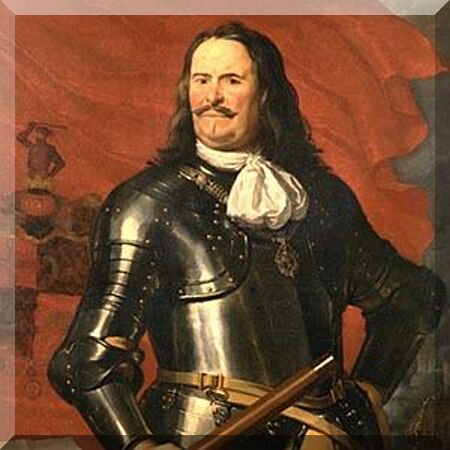
The famous
‘Admiral Michiel de Ruyter’.
Provided by Dr.
Johannes Meijer.
Construction and Design:
This remarkable vessel was built by Master Shipbuilder “Salomon Jansz van den
Tempel” between December 1664 and she was completed in August 1665 for
the “Admiralty of the Maas” in Rotterdam.
She had a length of
163 feet (46 m), a beam of 43 feet (12 m), and a hollow space of 16.5 feet (4.7
m). Her displacement was around 1,600 tons and she carried just over 2000 m≤ of
sail on her three masts. In addition she had a crew of around 420 personnel.
She was a three
massed ship and was fitted with some 80 cannons, which was later reduced to
76. Her name, “De Zeven ProvinciŽn,” translates to the
“The Seven Provinces”, which refers to the fact that the Dutch
Republic in the 17th century was a confederation of seven autonomous Provinces.
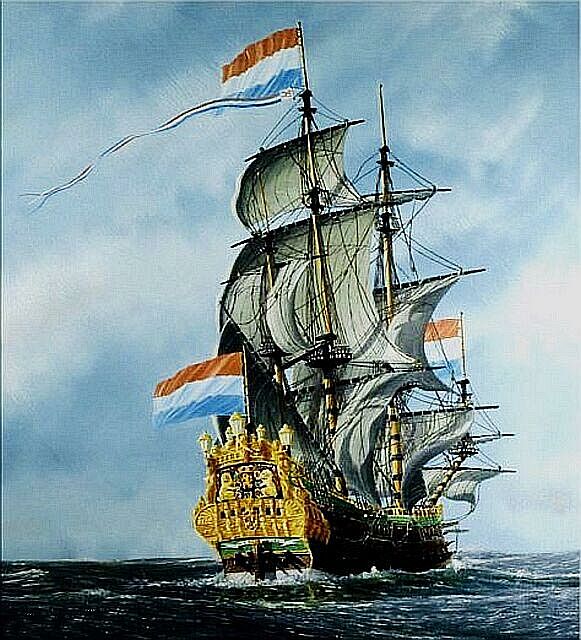
Here we see here amazing golden stern.
Provided by Dr.
Johannes Meijer.
Her Naval Service & Battles:
She commenced her
career as the temporary flagship of Vice Admiral “Aert Jansse van
Nes” who became her commander. However, soon thereafter she served as
“Admiral Michiel de Ruyter’s” flagship (1666 to 1674).
She took part in
the “Four Days Battle of North Foreland” (1666), followed by the
Two Days Battle” (1666), and the “Journey to Chatham” (1667)
in the “Second English War”. The ship also took part in the
“Battle of Solebay” (1672); as well as the double “Battle of
Schooneveld” (1673) and the “Battle of Kijkduin” (1673). In
1674 she headed off to an expedition to ‘Martinique’ under command
of ‘Admiral De Ruyter’.
However, after
‘De Ruyter’s’ death, she became the flagship of Rear
Admiral “Jan van Brakel” in 1678. Then in 1691 Rear Admiral
“Johan Snellen” was given command of this very famous ship,
however, he sadly passed away whilst being on board her that very same year. In
1694 “De Zeven ProvinciŽn” was finally decommissioned and she was
sold to be broken up.
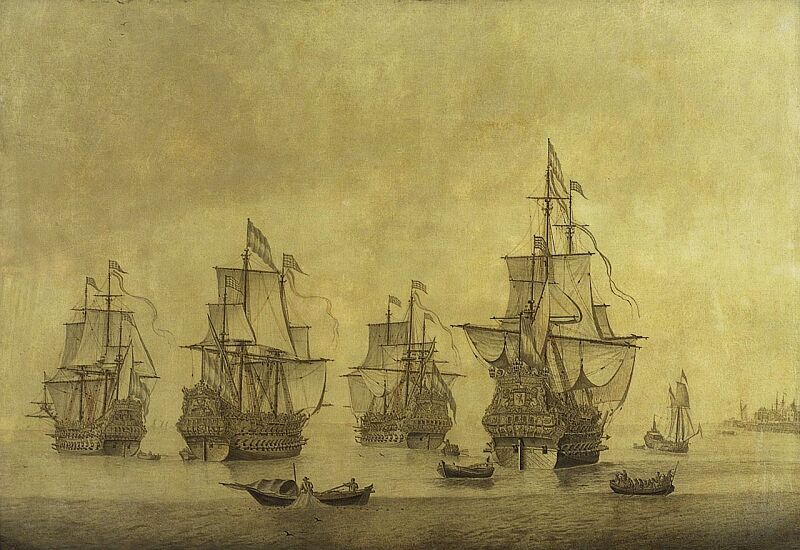
The ‘De Zeven ProvinciŽn’ is seen on the right, with other vessels ready for departure.
Provided by Dr.
Johannes Meijer.
The end of a brave
fighting lady of the sea!
Specifications:
Name: †††††††††††††††††††††††††††††††††††††
“De Zeven ProvinciŽn”
Built by: ††††††††††††††††††††††††††††††††††††††
“Admiralty Shipyard” at Haringvliet, Rotterdam.
Keel laid down: ††††††††††††††††††††††††† December 1664.
Completed: ††††††††††† ††††††††††††††††††††August 1665.
Length: †††††††††††††††††††††††††††††††††††††† 163 ft – 46 m.
Beam: †††††††††††††††††††††††††††††††††††††† 43 ft – 12 m.
Hollow space: †††††††††††††††††††††††††††††††† 16.5 ft – 4.7 m.
Displacement tonnage: †††††††† ††††††††††1,600 tons.
Masts: †††††††††††††††††††††††††††††††††††††† Three.
Sails: ††††††††††††††††††††††††††††††††††††††† 2,000 m≤.
Total Crew: ††††††††††††††††††††††††††††††† 420.
Armaments: ††††††††††††††††††††††††††††††† 80 cannons, later reduced to 74.
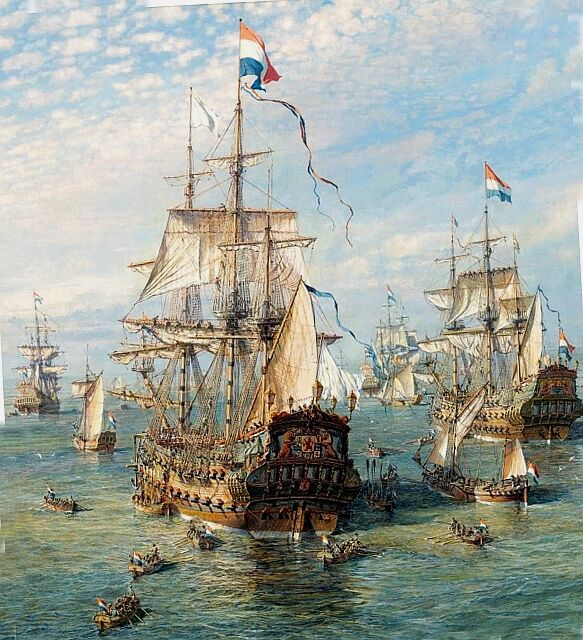
A fine painting of the ‘De Zeven Provincien’ and the fleet.
Provided by Dr.
Johannes Meijer.
A full listing of her entire history:
December 1664:
The ships keel of was laid down at the “Admiralty Shipyard”.
August
1665: “De Zeven ProvinciŽn” was completed, and Vice-Admiral
“Aert van Nes” was appointed as the commander of the new ship.
October
1665: At the mouth of the “River Thames”, she worked and
blocked the River.
November 3,
1665: she returns to Hellevoetsluis, being her base back in Rotterdam.
April 10, 1666: At
“Hellevoetsluis”, “Admiral “Michiel de
Ruyter” boarded her for the first time as her new commander. There is no
doubt, but he was one of the most famous Dutch sea-officers in all history!
May 6,
1666: At Hellevoetsluis “Admiral De
Ruyter” transfers his official flag to the newly commissioned “De
Zeven ProvinciŽn”.
June 10, 1666:
“Admiral De Ruyter” heads for France and anchors off Dunkirk.
June 11, 1666:
‘East, North East’ of North Foreland, England - The
“Four Day's Battle” commences. However, on board “De Zeven
ProvinciŽn”, French naval commander “Abraham Duquesne”
experiences the battle as an official observer.
June 12, 1666:
Still at North Foreland - “De Zeven ProviciŽn” looses her main
topmast in the fight. ‘De Ruyter’ withdraws to supervise repairs of
the ship, delegating temporary command once again to Lieutenant-Admiral “Aert
van Nes”
June 14, 1666: Over
at North Foreland, the Four Day’s Battle is over. The Dutch were so
powerful and thus beat England in a great victory.
July 1, 1666:
Admiral ‘De Ruyter’ anchors his fleet near Boulogne in France.
August 1, 1666:
Located just off Thames River estuary, ‘De Ruyter’ observes
the English fleet leaving port, earlier than expected.
August 3, 1666:
along the Flemish Coast but just after a storm which drove the Dutch fleet
to the flemish coast, However, soon enough
‘De Ruyter’ sails again to blockade Thames River.
July 8, 1666:
‘De Ruyter’ withraws from the Thames in order to head for
Dunkirk once again.
August 4,
1666: she was again near North Foreland, England “St.
James’s Day Battle” - an English victory at last.
October 14, 1666:
She was back on the River Maas in Rotterdam.
May 17, 1667:
‘De Ruyter’ heads to Texel to join with the squadrons of Amsterdam.
June 4,
1667: From Schooneveld, located at the Mouth of Scheldt River, De
Ruyter departs for the River Thames with some 62 ships, being grouped in 3
squadrons.
June 9, 1667: The
Dutch fleet were sighted off Sheerness. Thus another
Squadron sails to the Thames.
June 10, 1667: The
Dutch fleet arrives at the ‘Isle of Sheppey’ and launches an attack
on the incomplete Garrison Point Fort.
June 11, 1667: The
Dutch fleet sails up the River Medway. The English sank several of their ships
attempting to stop their progress.
June 12, 1667:
Having arrived, one of the four biggest English ships ever, the
“Royal Charles” was captured, whilst two of their ships were
completly destroyed by fire!
June 13, 1667: The
Dutch decided to return to the Netherlands, taking the “Royal
Charles” in tow with them
June 14, 1667: The
Dutch sail out of River Medway, having some 30 of the English ships either sunk, burned or captured.
June 16, 1667: At
the mouth of the ‘Scheldt River’ Prince Willem visits the ship
after the great and successful battle.
August 24, 1667:
Anchored off Mount Bay in Cornwall where the ‘Treaty of BREDA’ is
signed.
October 15, 1667:
“Admiral De Ruyter” returns home to the Hellevoetsluis, in the
Netherlands.
August 24, 1671:
Den Briel, Netherlands - The English Royal Yacht
“Merlin”, carrying the wife of the English ambassador ‘Sir
William Temple’ back to London, sails through the Dutch fleet at anchor
off Den Briel intent creating an incident to ignite the war for King
Charles II. However, “De Zeven ProvinciŽn” salutes the Royal Yacht
by firing white smoke, but the “Merlin” halts shooting in anger,
demanding that the Dutch strike their flag, which obviously does not happen!
January 1672: At
the ‘Admiralty Shipyard’ at Haringvliet, she
was refitted, her now she had become a 72-gun ship.
June 7, 1672:
The battle of Solebay took place, which was an strategic
Dutch Victory. The “De Zeven ProvinciŽn” completly cripples their
ship “Prince” during a 2-hour duel.
May 11, 1673:
Having been back at Hellevoetsluis, she once again sails out.
May 15, 1673: At
the mouth of the Scheldt River, “Admiral De Ruyter” retreats
to the Schooneveld when the English fleet prevents his plan to block
‘Medway River’.
June 7, 1673: The
first ‘Battle of Schooneveld’ on the North Sea.
June 14, 1673:
The second ‘Battle of Schooneveld’ a complete Dutch Victory.
August 21, 1673:
The battle off ‘Kijkduin’, on the North Sea known as the ‘Battle
of Texel’. This was a most clever and a strategic Dutch Victory!
May 24, 1674: The
Dutch fleet sails from Wielingen.
May 27, 1674: De
Ruyter arrives off Dover and salutes the fortress. Some English officers come
aboard and are amazed at the ships beauty!
June 8, 1674:
She departs from Hellevoetsluis and head’s for
‘Martinique’ with a fleet of 40 ships (18 ships-of-the-line,
20 *Fluyts and
six Fireships), with a total of 3,400 sailors and 4,000 soldiers.
*Fluyts Dutch type of cargo ship developed in the 17th century. They were being designed for efficiency and cost-effectiveness, making it a key vessel in the Dutch Golden Age of trade.
June 21, 1674: She
is seen just off Madeira Island.
June 24, 1674: She
arrives at Tenerife, Canary Islands and a stop is made at Tenerife.
September 19, 1674:
The Dutch fleet arrives at ‘Anses d'Arlet’ at Martinique.
July 20, 1674:
‘De Ruyter’ sails to the bay of ‘Fort-Royal’ and fires
at the harbour fort. The Dutch land their troops but are repelled by a
combination of crossfire from the fort, entrenched French soldiers and an
anchored French warship. The Dutch casualties total 143 killed and 318 wounded,
against only 15 French.
July 21, 1674:
‘De Ruyter’ sails north to Dominica to recuperate.
July 26, 1674:
‘De Ruyter’ sails past Guadeloupe on his way to Nevis.
July 28, 1674:
Visit to the English at Nevis. Some prisoners are exchanged for meat and fruits.
August 24, 167:
Latitude of Lisbon, Portugal. After almost a month of calms, ‘De
Ruyter’ sails into a violent storm.
September 30, 1674:
Back in Holland at Goeree Island.
August 1, 1675: At
Hellevoetsluis, Netherlands, ‘De Ruyter’ switches to another
flagship, the “Eendraght” because the
“De Zeven ProvinciŽn” was in bad shape and needing
maintenance and repair, and therefore not suited to the planned expedition to
the Mediterranean Sea in 1676.
January,
1678: She becomes the flagship of “Rear Admiral Jan
van Brakel”.
February, 1678:
She sails for Spain in the “Cornelis Evertsen de
Younger’s” fleet.
March 17, 1678:
‘Evertsen’s’ fleet of 25 ships is attacked
by Ch‚teaurenault off Ouessant.
March 24, 1678:
“Jan Van Brakel” attacks an algerian privateer
off Cape St.Vincent, Portugal.
March 26, 1678: The
squadron arrives at Cadiz, Spain.
March 27,
1678: Letter from ‘Van Brakel’ to the Admiralty of the
Maze from the "De Zeven ProvinciŽn", anchored at Cadiz.
May 30, 1678: At
Cadiz the “Evertsen” sails for Barcelona carrying Spanish
soldiers to the front.
June(?) 10, 1678: Barcelona, Spain
- Evertsen reaches Barcelona.
July(?) 1, 1678: After more than 3 weeks at
Barcelona, Evertsen sets sail to Alicante, Barcelona.
July(?) 5, 1678: Alicante, Spain - Arrives
at Alicante.
July(?) 15, 1678: MŠlaga, Spain
- Sails to MŠlaga.
August(?) 1, 1678: Cadiz, Spain - Returns to
Cadiz on his way back to the Netherlands.
September 30, 1678:
She Arrives at Texel from Spain in the end of September.
July 10, 1690: Near
Eastbourne English Channel - Battle of Beachy Head - French
Victory.
April 21, 1691:
Hellevoetsluis, Netherlands – “Rear Admiral
Johan Snellen” is appointed commander of the ship.
June 18, 1691: The
Anglo-Dutch fleet is anchored at the Downs.
August 24, 1691:
“Rear Admiral Johan Snellen” dies in his sleep while the ship
is off the port of Torbay.
September 7, 1691:
The anglo-dutch fleet sets sail to the Scilly Islands area.
September 9, 1691:
The fleet passes Plymouth sailing to the west.
September 10, 1691:
The fleet comes in sight of Ouessant/Ushant.
September 11, 1691:
The fleet sails to a patrol point 50km WSW of Cape Lizard.
September 12, 1691:
At 50km WSW of Cape Lizard the fleet runs into a violent storm.
September 13, 1691
- Torbay, England - The Anglo-Dutch fleet returns to Torbay.
May 7, 1692: Bound
for Ray Bay, England, to join the English fleet.
May 19, 1692: Off
Cap Barfleur, Contentin Peninsula, France, both fleets sight
each other.
May 29,
1692: Off Contentin Peninsula, Battle
of Barfleur commmences, although who won is Inconclusive.
June 4,
1692: At Saint-Vaast-la-Hougue, the Battle of La Hogue concludes with
the Anglo-Dutch huge victory. However the
"De Zeven ProviciŽn" is sadly damaged.
June 6, 1692:
- After some limited repairs, she sails to Portsmouth, England to repair
the leaking hull. and to obtain new rigging, masts and
yard’s.
June 23, 1692:
She Departs from Portsmouth into the English Channel.
October 7, 1692:
Rejoins the Dutch fleet in the English Channel.
November 1,
1692: From Hellevoetsluis, Netherlands she sails for Rotterdam.
November 2, 1692:
Arrives at Rotterdam and she was laid up at Rotterdam.
January 1, 1694:
Due to her damages are considered to great and not repairable she was sold
to be broken up.
Please Note:
All images on this
page were kindly provided by the now elderly “Dr.
Johannes Meijer” from South Africa.
In conclusion:
The “De Zeven
ProvinciŽn” was also part of a combined Dutch-English fleet led by
“Edward Russel” in 1692 where it was damaged by the French
during the “Battle of La Hogue”. Sadly, as seen, this final battle
she was severely damaged at the “La Hogue” battle. Although her
last commander was Captain “Evert de Lieffde”, whose logbook
from 1692 has been preserved.
The magnificent
“De Zeven ProvinciŽn” had finally come to the end of her courageous
career, and sadly she was sold and subsequently broken up in 1694. Apart from
the “De Zeven ProvinciŽn” the other ships shown were built around
1666.
The end of a brave
fighting lady of the sea!
*************************
“Blue Water Liners sailing to the
distant shores.
I watched them come, I watched them go and I watched them die.”
Amazingly: ssmaritime.com has received 7,579 Billion reader’s since
1992.
Although, the last update was on: Sunday November 24, 2024.
Remember many readers have read different pages & ships countless of
times,
In addition certain features have up to 20 plus pages, and that is a great
deal of reading!
Email: rg@ssmaritime.com
Click or copy the email above.
**************************
Where the ships of the past and Cruise
Ships of today make history.
The author has been in Passenger Shipping & the Cruise Industry since
1960.
Having been a “Managing Director”, and
“Operated a Cruise Company”
In addition he was founder of “Save the Classic Liners
Campaign” in 1990.
Please Note: ssmaritime and associated sites are 100% non-commercial and the
author seeks no funding of any shape or
form, never have and never will!
Photographs on ssmaritime and
associate pages are by; the author or from the author’s private
collection. In addition there are some images that
have been provided by Shipping Companies as well as private photographers or
collectors. Credit is given to all contributors. However, there are some
photographs provided to me without details regarding the photographer /owner
concerned, if here is someone who has details, please advise
me.
This notice covers all
pages; although, and I have done my best to ensure that all photographs
are duly credited and that this notice is displaced on each page, that is, when
a page is updated!
ssMaritime is owned & © Copyright Reuben Goossens - All
Rights Reserved.